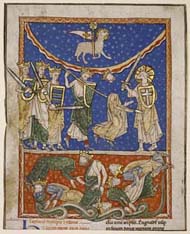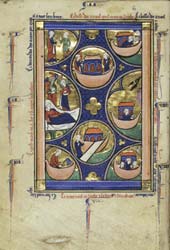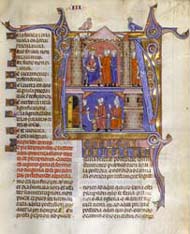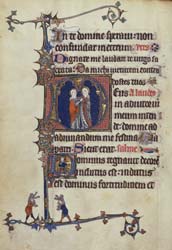 |

 |
 |
The Lamb Defeating the Ten Kings, Spanish, about 1200–1250
Recent Acquisition
|
 |
Featuring whimsical marginal decorations, vivid narratives, and the lavish use of gold leaf, Gothic illumination is among the most innovative and beautiful art forms of the Middle Ages. Gothic was a term originally coined by Renaissance writers who disliked the nonclassical style of architecture that emerged in France around 1150, which they attributed to the barbarian Goths. Its early negative meaning has long since been lost. The word is now also applied to the style of manuscript illumination that evolved around the same time, characterized by a naturalistic style of painting and a sense of liveliness in the format of the page. Gothic illumination, which flourished in northern Europe from about 1200 to 1350, graced the pages of some of the most stunning works of art to survive from the Middle Ages.
The miniature seen here, from a manuscript of the Apocalypse, illustrates how the Lamb of God conquered a succession of kings who were then turned over to a horrible beast. One characteristic of early Gothic painting is the naturalism seen in the drapery of the king in the top center, which falls in graceful folds and helps define the movements of his body.
|
 |
|
Jealous of David's popularity at court, King Saul threateningly draws his sword against him as David flees with his harp. The image, inspired by events in the Bible, exemplifies the naturalism introduced into French illumination around 1200.
The artist portrays both the physical and psychological aspects of the event. Saul's evil intentions are indicated through his facial expression, which is echoed by the demon leaning over his shoulder. The king's menacing gesture is heightened by the tilt of his body toward David, and the sword that pierces the confines of the letter Q containing the scene. David's fear is apparent as he locks eyes with Saul. His desire to escape is conveyed through the position of his left foot, which can be seen emerging from behind the letter.
|
 |
|
This initial E houses a depiction of the most memorable event of the story of the prophet Jonah. During the course of a ferocious storm, sailors aboard Jonah's boat decided that he had angered God and brought on the tempest. In the initial, two sailors throw the prophet overboard and into the mouth of an enormous fish.
Concerned with naturalistic visual effects, the artist suggested the transparency of the water, through which the boat, the fish, and Jonah can be seen. The artist also showed the individual vertebrae of Jonah's spine as a series of small circles going up his back. The center bar of the letter E was treated as a physical object, over which the sailors flip the unfortunate Jonah.
|
 |
|
During the Gothic era, artists began to experiment with design and format to increase the decorative effect of the page. One of the most enchanting innovations was the extensive use of the margins.
In this initial that opens Psalm 38: "I said, 'I will take heed to my ways that I not sin with my tongue,' " King David points to his mouth. With his other hand, he gestures toward the seated woman at the bottom of the page. She, in turn, points toward a soldier, who points his spear toward David. Although the figures seem to have no direct relationship to the text, their gestures create a circle that links the figures and guides the viewer's eye around the page. At the top of the page, a dog chases a leaping rabbit, repeating the movements of the two figures at the bottom.
|
 |
 |

 |
 |
Scenes from the Life of Noah, Paris, about 1250–1260
|
 |
Other art forms also influenced the look of the painted page in the Gothic era, such as stained glass, with its emphasis on geometric shapes and predominant use of red and blue.
The story of Noah and his ark is told on this page through a series of circular and semicircular scenes rendered with bold colors in relatively flat, well-defined areas. The effect is similar to the stained-glass windows of cathedrals of the 1200s. The use of blues and reds in jewel tones and defined geometric shapes allowed the artist to simplify the compositions of the interrelated scenes.
  Compare to Gothic stained glass in the exhibition Images in Light: Newly Acquired Stained Glass. Compare to Gothic stained glass in the exhibition Images in Light: Newly Acquired Stained Glass.
|
 |

 |
 |
Initial A: Two Men before a King and a Man Speaking to a Family, northeastern Spain, about 1290–1310
|
 |
 |
|
|
 |
During the early Middle Ages, manuscripts were largely produced by monks in monasteries. But in the Gothic era manuscript illumination became the province of professional artists working in rapidly growing European cities where the great cathedrals were under construction and the first universities were being founded. Beyond religious manuscripts, artists were commissioned to illuminate a wide variety of secular books including law texts, scholarly literature, histories, and romances.
This manuscript contains a compilation of medieval Spanish law, called the Vidal Mayor. This initial concerns a case brought before the king (in the top half) regarding the property rights of a young orphan (in the bottom half). The manuscript is illustrated with more than 150 historiated initials like this one that help clarify the meaning of the complex legal text.
|
 |
 |

 |
 |
Initial D: The Visitation, Northeastern France, about 1300
|
 |
Professional artists produced religious manuscripts in great quantities, not only for the Church, but also for people who were neither monks nor nuns, but simply pious Christians.
This manuscript is an early example of a popular type of book known as a book of hours, which contains a series of prayers to be said at various times throughout the day. The contents were intended to echo the daily prayers said by monks and nuns, providing ordinary Christians with a way of participating in the experience of private devotion. Books of hours were also used by mothers to teach reading and basic Christian beliefs to children.
The large initial D seen here contains an image of the Visitation, when the Virgin Mary visited her cousin Elizabeth and told her of Christ's impending birth.
|
 |